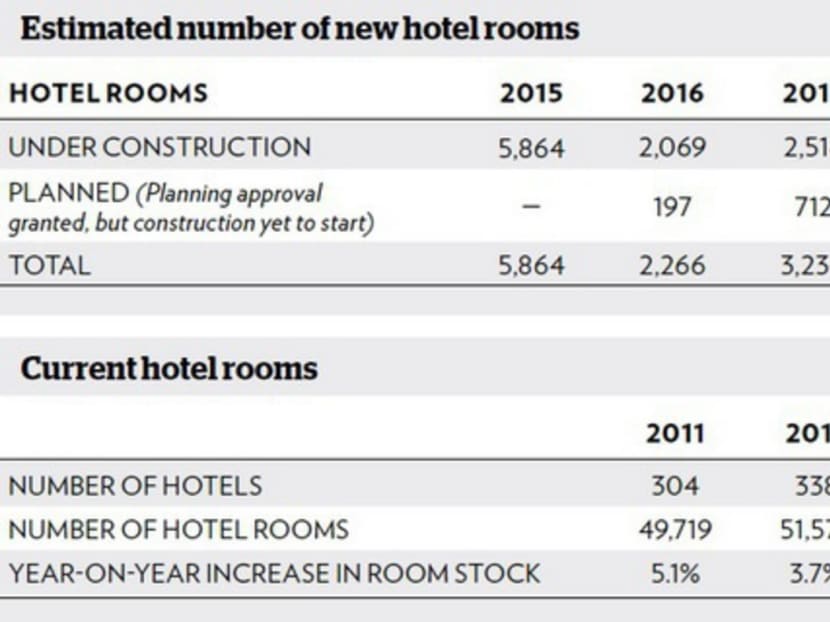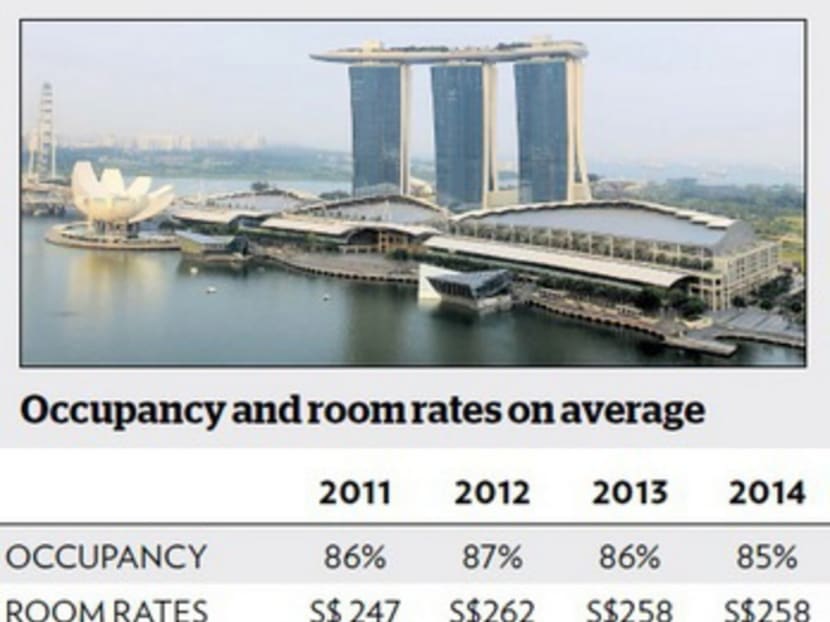Hotels pulling out all stops to draw more customers
SINGAPORE — Smaller and newer players in the hotel industry are starting to feel the strain from the double whammy of a growing stockpile of hotel rooms in recent years and the first sign of dipping tourist arrivals.
SINGAPORE — Smaller and newer players in the hotel industry are starting to feel the strain from the double whammy of a growing stockpile of hotel rooms in recent years and the first sign of dipping tourist arrivals.
And to stay afloat amid an increasingly competitive environment, they are pulling out all stops to draw more customers, including slashing room rates by up to 40 per cent during off-peak periods, targeting new market segments, and in some cases, undergoing facelifts.
Buoyed by year after year of record visitor influx in recent years partly because of mega-events such as the F1 Singapore Grand Prix and the opening of the Integrated Resorts, acute demand has caused room rates to edge up quickly even as more rooms were added to the inventory. For instance, in September 2012, average room rates hit a four-year high of S$280.
In the past four years, occupancy has hovered around 85 per cent, despite an average annual increase of 4.9 per cent in hotel room inventory in that period, figures from the Singapore Tourism Board (STB) showed.
But with the STB’s estimates last Wednesday indicating visitorship last year fell for the first time since 2009 — the global economy was then in the throes of the financial crisis — some hoteliers are starting to sweat over their game plan to deal with the crop of rooms that are slated to open in the next four years. This, especially as the Government has signalled a shift away from growing tourist numbers.
Since 2011, eight land parcels under the Government Land Sales programme have been sold to hotel developers, the Urban Redevelopment Authority (URA) told TODAY. There will be more than 13,000 rooms from the hotels that are being built or have been approved, representing nearly a quarter of the current room stockpile, URA figures show. The land parcels released for tender for the first half of this year also include a white site, which can be used for hotel development.
Some small players, however, are already feeling the effects from the slowdown. J8 Hotel, a 98-room boutique hotel which opened in December 2013 in Little India, for instance, found itself struggling to fill rooms in the last two months of last year although it has traditionally been a high season for travel.
Excluding Christmas and New Year’s Eve, occupancy was below 50 per cent on some days, said marketing manager Gary Puan. “It was very bad compared to industry-wide figures for this period from previous years,” he said.
Other than stepping up sales and marketing efforts, including offering promotions, the hotel has been paying more attention to wooing business travellers. “They’re more reliable, because they’ll always be (coming), even if there’s a decline in leisure travellers,” added Mr Puan.
Slightly bigger and more established hotels are also seeing a difference from the boom years.
The 288-room Link Hotel, a seven-year-old development in Tiong Bahru, said business has fallen, although it declined to reveal occupancy rates.
“The (tourism) pie is now spread across more hotels,” said Ms Calista Lee, the hotel’s marketing and communications assistant manager. “We’ve had regular guests giving us feedback that they’ll be trying out new hotels the next time they visit Singapore.”
In response, the Link Hotel is undergoing a major facelift and rebranding later this year.
Other hotels, meanwhile, are turning their attention to new market segments, such as local customers and tourists from smaller source countries.
Naumi Hospitality, which has an inventory of 152 rooms, saw a drop last year in group tourists from China, Malaysia and Hong Kong. It began reaching out to growing markets, such as South Korea and Taiwan, to “target travellers looking for non-cookie-cutter type hotels or off-the-beaten-track experiences in Singapore”, said sales director Poom Monterde.
Analysts said the trend portends a slide in occupancy and room rates, for incumbents and players entering the market. Ms Shirley Tee, manager of the School of Business Management at Nanyang Polytechnic, said: “With new properties, there is pressure to deliver a decent occupancy rate, so there may be pressure on room prices.”
Mid-tier hotels are already bearing the brunt of these developments, noted Dr Michael Chiam, a tourism lecturer at Ngee Ann Polytechnic.
“Upper-class hotels are still drawing a good market share. Budget ones should be doing reasonably well, with more cities connected to us via low-cost carriers,” he said. “It’s the ones in the middle that are seeing a bit of a squeeze, especially since their price range is quite close to boutique hotels.”
Ms Emma Meyer, course chair for the tourism and resort management diploma at Singapore Polytechnic, said hotels need to identify new market segments or offer value-added services. “With more rooms being added, hotels need to review their service strategy on how they can keep loyal guests coming back and how they can bring more new guests to their hotel,” she said.
“It is not the number of nights that matters, but the amount spent by guests per stay. This is made possible by delivering highly personalised service and consistent service standards.”








